Capybaras (Hydrochoerus hydrochaeris) are social mammals native to the forest, swamps, marshes, and tropical rainforests of Central and South America.
The animal, ever since its discovery in the last three centuries, has been a subject of various debates due to its many obscure characteristics. While they have been classified under the pig family sometimes in the past, they are known recently as a rodent, a semi-aquatic rodent, and the largest one.
The strangeness of these animals extends across many aspects of their living, like eating their own dung, chewing and regurgitating their food as seen in cud-chewing cattle, their harem-based breeding system, their mating in water, and many more. In this post, however, I’ll discuss one of its most distinguishing attributes. Its friendliness and relationships with other animals.
To better our understanding of the subject, we must first understand what kind of animal capybaras are—we must have an inkling of their behavioral pattern and territorial traits.
RECOMMENDED: Incredible Facts About Capybara Reproduction
Capybara Socialization Pattern
Capybaras are gregarious creatures that live in herds of up to ten to twenty individuals, consisting of a minimum of two adult males and four females and a maximum of four adult males and seven adult females and their juveniles, depending on the season.
Larger aggregations may be seen together during the dry season. There is always a dominant male within the group and several other subordinates.
The dominant males are domineering and seek the protection of the females and their young ones, and may not be able to stop the females from breeding with other subordinates in the group. Studies have proven that capybaras form cohesive groups characterized by a complex social structure with a dominant power structure and an individual specialization of functions.
They are crespular creatures (meaning they are most active in the morning and evening) and spend most of the hottest phase of the day wallowing in water or mud.
They graze in the late afternoon and early evening. They are equally agile on land and in water. Their activity and inactivity at night depend on the presence of possible predators and threats. Bachelor groups do not exist within Capybaras, and most males belonging to no group have little protection from predators and a slim survival rate.
MUST – KNOW: Why Are Capybaras Called The Friendliest Animals In The World?
Capybara Territorial Lifestyle
Each group of capybaras maintains and protects a territory that encompasses grazing and wallowing sites that may remain stable for years. Capybaras bark at intruders, and each dominant male of the group often exhibits this.
Or may sometimes serve as a signal of imminent danger from subordinate males. Males may also grow more aggressive with the increase in the male population in groups. Sometimes, a fight ensues between the dominant male and subordinates, and both may be seen rushing at each other, rearing on hind legs, or grappling with each other.
Subordinate males are seen occupying positions on the edge of the group, away from the dominant males. Both sexes are capable of scent-marking, and this may play a major role in defining territories and partners. Female capybaras usually scent-mark less when compared with their males.
Another thing worthy of note is getting familiar with their natural habitat and range. This will further our knowledge of their relationship with other animals and their adaptation to their immediate environment.
Where Do Capybaras Love To Live?
Capybaras’ habitat ranges from densely forested areas, lowland forests, dry forests, scrubs, and grasslands to water-accessible grasslands, marshes, swamps, ponds, lakes, and flooded savannahs. They inhabit warmer climates and tropical rainforests like those in Central and South America.
DON’T MISS: NEW STUDIES Show Why Capybaras Can’t Survive Without Water
What Animals Live With Capybaras?
Owing to their relaxed and calm nature, capybaras may be seen with monkeys, birds, small mammals, and even large predators like crocodiles are seen hanging around them.
Capybaras may be seen with birds, Gooses, Ducks, Turtles, alligators, and other aquatic animals, depending on their semi-aquatic nature.
Will A Capybara Attack A Human?
Capybara Relationship With Humans: Capybaras are gentle, genial, and generally relaxed in nature. And due to all these attributes, Humans have peacefully lived alongside Capybaras for hundreds of years.
They have been kept as pets, domesticated, and farmed for their meat, grease, hide, and furs. Capybaras are also kept in Zoos, where they are fed and are able to live longer in this condition than in their natural habitat.
They are, in every sense of the word, harmless to humans and animals alike. But when threatened or harmed, they have been documented and seen to exhibit aggressive-like habits like biting and making a short bark-like sound.
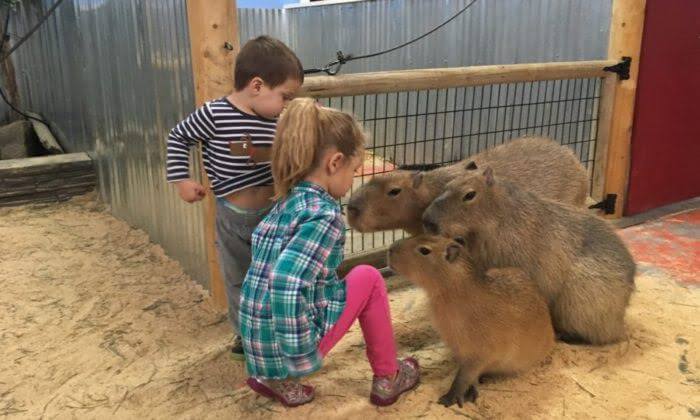
However, they may not be aggressive animals but are often killed in certain areas for their meat and skin, leading to population declines in some of these regions. The Capybara has also been affected by Human activity in their native regions in general, including both growing Human settlements and land clearance for agriculture.
It is in these areas, particularly, that when there is not an adequate supply of food available, some Capybara have been known to enter crop fields where they can cause a great deal of damage and can be seen as pests.
Captive Capybaras have been kept as pets and domesticated by humans for a long. And they have been recorded to live under these conditions as long as they are provided with easy access to a pool, grasses to graze on, and fruits for sustenance.
Capybaras are also farmed by humans, who engage in such practices due to the many benefits they gain from the animal. Humans farm capybaras for their good meat, the grease on their fur, their hide, which may be used in leather making, and their furs.
These practices have helped protect the capybaras left in the wild and their wild habitat, which, in turn, helps all the plants and animals that call that habitat home.
Of all the aforementioned interactions and relationships with humans. Keeping capybaras in zoos may seem the safest and wisest choice for humans and animals. Capybaras are well-tended, catered for, and can socialize with other animals when kept in zoos.
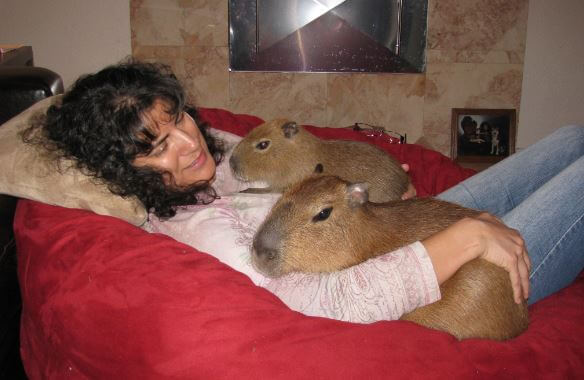
Living under utmost care not only helps Capybaras achieve a much longer span when compared to their life in the wild, it can also help with their breeding efficiency.
At the San Diego Zoo, they had their Capybaras trained to walk onto a scale for their monthly weight checks, come into their bedroom area when called, go into crates, and sit still for a quick physical evaluation. All this is accomplished with the aid of a powerful motivator—food.
DON’T MISS: Can Capybaras Be Kept As Pets? (5 Vital Things You Should Know First)
Capybara Relationship With Monkeys
Though polar opposite in nature, there seems to exist a sort of agreement between monkeys and Capybaras. Where Monkeys are playful, fun-loving, and sometimes mischievous, capybaras are gentle through and through and have no problem with anyone or anything around them; so far, they are not hurt.
They also find pleasure in wallowing in mud, swimming in lakes, and sometimes lounging in an open field.
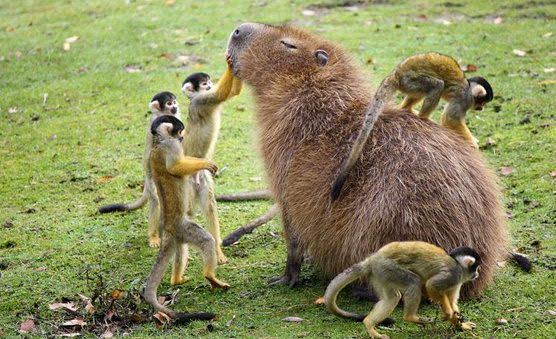
The cordiality between monkeys and Capybaras is evident in zoos and sometimes in the wild, where Capybaras are seen cushioning monkeys on their backs.
Moreover, their relationship may sometimes gear toward mutualism/symbiosis, and this is because Monkeys are insect eaters and may pick at ticks, bugs, and other insects stuck under or on the fur of Capybaras.
Hence, both animals benefit from this relationship – the Capybara’s fur is being rid of insects, and the Monkey is earning its meal from this action.
Capybaras Relationship With Birds
Birds like monkeys are also seen hanging around Capybaras at all times. And as seen in cattle, most birds piggyback on the backs of Capybaras. Ducks and other birds can also be seen moving in flocks with Capybaras to stress their peaceful coexistence further.
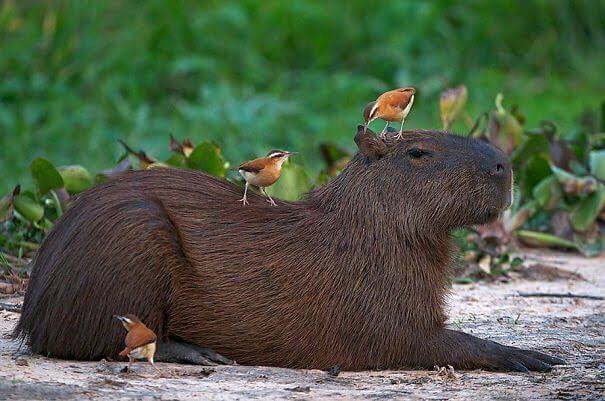
The relationship between Capybaras and most birds, like the yellow-headed Caracaras, is mainly symbiotic, as the birds can feed off the bugs and remnants of foods stuck on the furry creatures’ bodies. At the same time, the Capybaras, on the other hand, are made clean through this mutual alliance.
Capybaras Relationship With Crocodiles & Alligators
On several occasions, capybaras have been seen hanging around large semi-aquatic predators like Crocodiles and Alligators. And this may be because these large predatory creatures have a very slow metabolism and can survive long periods without food.
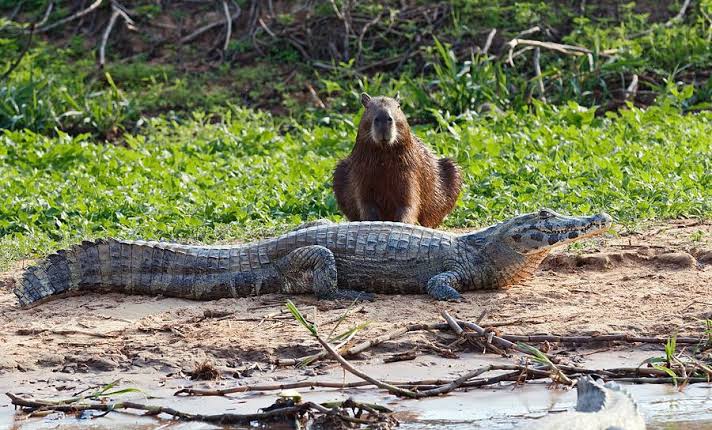
From this, we can deduce that the union between Capybaras and these Armored-skin creatures is possible. Another strange thing worthy of note is the sight of Capybaras with one of their widely known predators – the Caiman (an animal that looks just like the crocodile), which was claimed to be common and had surfaced on the internet.
Capybaras Relationship With Cats And Other Rodents
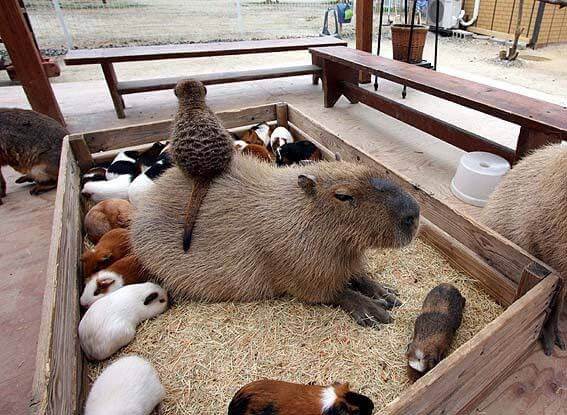
Both Friendly and cozy, Capybaras and cats get along just fine and can be real pals as threats and harm are kept out of their relationship. Capybaras can be seen hanging out with cats, cuddling with them, and tolerating them.
They also maintain a cordial relationship with mice, other rodents, and anteaters.

RECOMMENDED: Complete Beginner’s Guide To Grooming A Capybara As Pet
Can Capybaras Attack Other Animals?
As with other animals in the wild, capybaras show a little aggression, mostly as a form of defense against threats rather than anything. Aggressive attributes like snarling, rearing up on their hind legs, clawing, and biting are observed in Capybaras.
However, these actions are mainly a reaction to territorial infringement since they are animals who value territorial observance so much.
Do Capybaras Like To Cuddle?
Very well. Given their friendly disposition and sociable nature, Capybaras can be seen cuddling together in groups close to waterholes and within the range of their territory. And due to their mammalian characteristic, young capybaras are also seen nuzzling with adult females in the group.
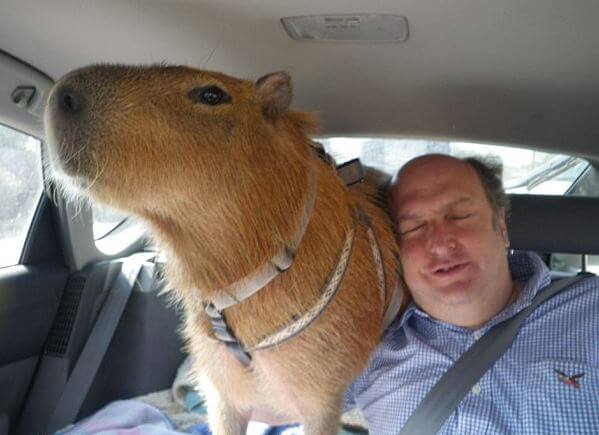
Capybaras are playful and friendly when kept as pets and can cuddle with their owners. Observing their relationship with other animals has also proven that Capybaras cuddle with other animals. Animals like cats and monkeys have been seen cuddling with Capybaras.
Will Capybaras Go Extinct?
According to the IUCN assessment in 2016, Capybaras were listed to be of the least concern for extinction in the nearest future due to their fairly stable population throughout Central and South America’s natural range.
However, their population may have declined in certain areas due to their indiscriminate hunting by men, loss of natural habitat by deforestation, and increased water pollution levels.
Other men’s activities like bush burning and encroachment may play a major role in the decline in their numbers in recent times.
Capybara Predators And Threats
Despite this large rodent’s large size and secretive aquatic nature, their slow and gentle disposition makes them a rewarding meal for numerous hungry predators throughout their natural range.
Wildcats, including Jaguars, Pumas, and Ocelots, are the primary predators of the Capybara, along with Caimans and Eagles that can hunt the younger ones from the sky above.
The Capybara is also one of the best sources of food for the world’s heaviest snake, the Anaconda, along with other known dangerous species of a large snake.
READ THIS: Do Pelicans Eat Capybaras?
Some Facts About Capybaras You Should Know
There are lots of interesting facts to know about capybaras. One of them is that seventy-five percent of a capybara’s diet is only three to six plant species.
Some extinct cousins of the capybara were twice as long and probably weighed eight times as much as their modern-day relatives. Capybaras are so trainable that in Surinam, a blind man once used a capybara as a guide animal.
Fossils of the extinct Pinckney’s capybara have been found in San Diego County’s Oceanside.
DON’T MISS: What Capybaras Need To Survive Anywhere
In the 16th century, the Catholic Church classified the capybara, which can swim, as a fish so that the meat could be eaten on Fridays and during Lent. Capybaras may enjoy belly rubs and foot massages and love to be hand-fed.
Capybaras may sometimes scratch at someone or other animals, and they make a strange vocalization between themselves as means of communication.
Do you have any questions after reading this post? Kindly ask using the comment section below, and we will fastly attend to it. Thanks for reading, and don’t forget to share this with someone.

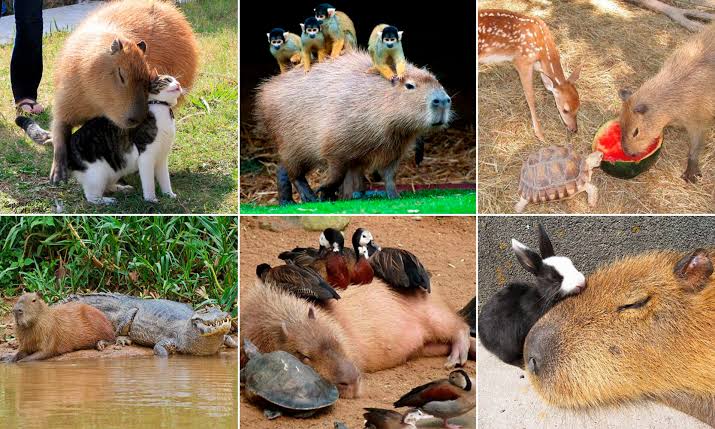
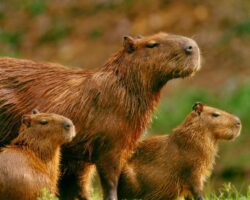
![Capybara Meat And Its Culinary Uses - [Every You Should Know] Capybara Meat & Culinary Uses](https://capybaratips.com/wp-content/uploads/2023/03/Capybara-meat-250x200.webp)
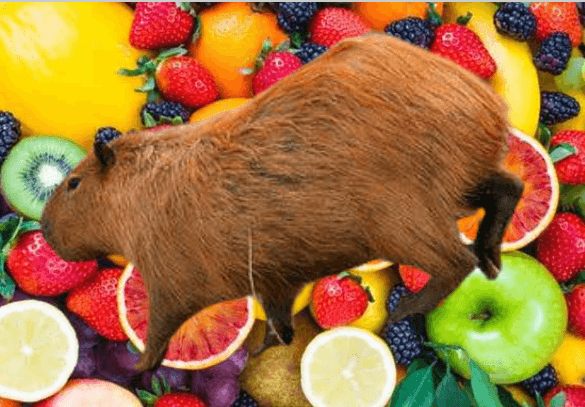
![Why Do Capybaras Not Have Tails? - [Answered] Why Do Capybaras Not Have Tails](https://capybaratips.com/wp-content/uploads/2023/03/Capy-Tail-250x200.webp)
![How Long Do Capybaras Live? - [Answered] How Long Do Capybaras Live](https://capybaratips.com/wp-content/uploads/2023/03/Capybara-Pix-250x200.webp)
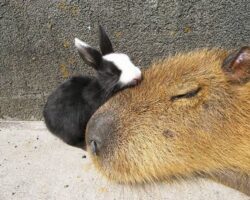

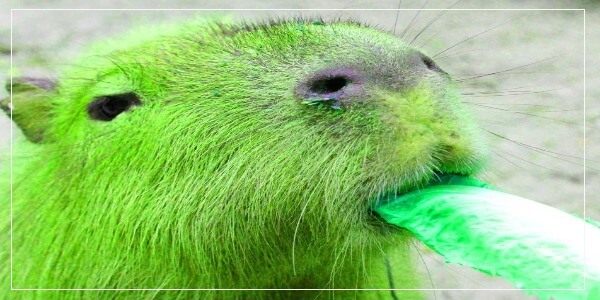
yasss great article i love it